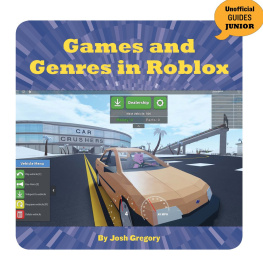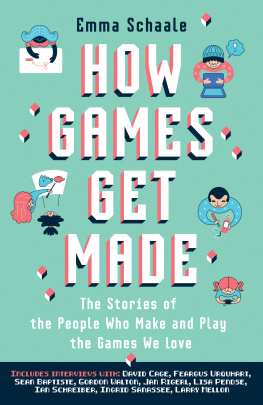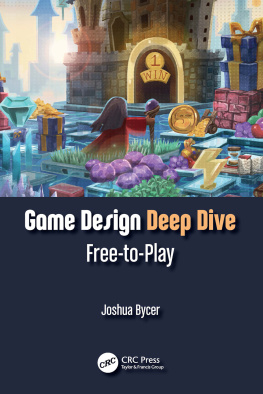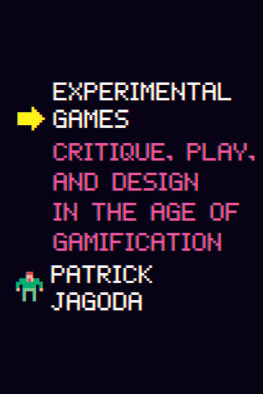Jane Jensen
Influential Video Game Designers
Series Editors:
Carly A. Kocurek
Jennifer deWinter
Jane Jensen
Gabriel Knight, Adventure Games,
Hidden Objects
Anastasia Salter
Bloomsbury Academic
An imprint of Bloomsbury Publishing Inc

Bloomsbury Academic
An imprint of Bloomsbury Publishing Inc
1385 Broadway New York NY 10018 USA
50 Bedford Square London WC1B 3DP UK
www.bloomsbury.com
BLOOMSBURY and the Diana logo are trademarks of Bloomsbury Publishing Plc
First published 2017
Anastasia Salter, 2017
All rights reserved. No part of this publication may be reproduced or transmitted in any form or by any means, electronic or mechanical, including photocopying, recording, or any information storage or retrieval system, without prior permission in writing from the publishers.
No responsibility for loss caused to any individual or organization acting on or refraining from action as a result of the material in this publication can be accepted by Bloomsbury or the author.
Library of Congress Cataloging-in-Publication Data
Names: Salter, Anastasia, 1984 author.
Title: Jane Jensen: Gabriel Knight, adventure games,
hidden objects / Anastasia Marie Salter.
Description: New York: Bloomsbury Academic, An imprint of Bloomsbury
Publishing Inc, 2017. | Series: Influential Video Game Designers |
Includes bibliographical references and index.
Identifiers: LCCN 2016043964 (print) | LCCN 2016047892 (ebook) |
ISBN 9781501327452 (Hardback: alk. paper) |
ISBN 9781501327469 (Paperback: alk. paper) | ISBN 9781501327438 (ePub) |
ISBN 9781501327421 (ePDF) | ISBN 9781501327438 (ePUB)
Subjects: LCSH: Jensen, Jane. | Video
gamesDesignHistory. | Video gamesAuthorship. | Computer programmersUnited StatesBiography. |
Novelists, American20th centuryBiography.
Classification: LCC GV1469.3 .S214 2017 (print) |
LCC GV1469.3 (ebook) | DDC 794.8dc23
LC record available at https://lccn.loc.gov/2016043964
ISBN: HB: 978-1-5013-2745-2
PB: 978-1-5013-2746-9
ePub: 978-1-5013-2743-8
ePDF: 978-1-5013-2742-1
Series: Influential Video Game Designers
Cover design: Alice Marwick
Contents
I grew up on adventure games. I played my first Gabriel Knight game as a kid, and the voodoo-filled nightmares it fueled haunted me in a way no other game had. I remember seeking out every new game in the genre, and particularly following all the news of Jane Jensens upcoming projects. Without my parents introducing me to those games, there is no way Id be in the field I am in now. Thank you first and foremost to Jane Jensen and her fellow designers for building a genre that showed me what interactive storytelling could be. Several people made this book possible: series editors Jennifer deWinter and Carly Kocurek provided invaluable feedback and guidance throughout the process and introduced me to a new way of writing about authorship in a field of study where we are often more concerned with objects. While writing this book, I stayed in Rochester, New York, to research in the collections at The Strong National Museum of Play. Thanks to Christopher Bench and the fellowship team for providing me with funding to make the trip possible, and thanks to the amazing team at the archives for all your help.
Throughout my work I have relied on feedback and support from the community of the Electronic Literature Organization and our annual conference. To name only a few (in alphabetical order): Kathi Inman Berens, Stephanie Boluk, Leonardo Flores, Jacob Garbe, Dene Grigar, Matthew Kirschenbaum, Flourish Klink, Kari Kraus, Deena Larsen, Liz Losh, Marjorie Luesebrink, Mark Marino, Nick Montfort, Stuart Moulthrop, John Murray, and Mark Sample. Many other games scholars have provided insight and inspiration, including Bridget Blodgett, Edmond Chang, Shira Chess, Nick Sousanis, and Laine Nooney. Also, at the University of Central Florida, thanks to my colleagues and students in the Games Research Group and the Text & Technology program for ideas and inspiration, with particular thanks to Rudy McDaniel, Joseph Fanfarelli, Peter Smith, Matthew Mosher, Barry Mauer, Mel Stanfill, Natalie Underberg-Goode, and Anne Sullivan.
Each of the designers featured in this series demonstrates their own approach to design; Jane Jensen is no exception. Jensen began her career at Sierra On-Line, and her work at Sierra, in particular the Gabriel Knight series, is what she is best known for. But as Anastasia Salter demonstrates, Jensens best-known work is only part of a larger body marked by unorthodox approaches. Salter forwards that Jensen is a writer-designer, someone whose writing functions as a design process. Writing was Jensens entre into the industry and is foundational to understanding her unique approach.
Writing for gamesand creating games by writingare both timely topics. The advent of Twine and other interactive storytelling tools have made the production of narrative games accessible to novices and invited experimentation and innovation from new and experienced designers alike. Contemporary books like Evan Skolnicks Video Game Storytelling: What Every Developer Needs to Know about Narrative Techniques and Tobias Heussner, Toiya Kristen Finley, Jennifer Brandes Hepler, and Ann Lemays The Game Narrative Toolbox are aimed at an audience of established and aspiring developers interested in writing and narrative as key tools for game production. Games writing, along with the rest of the industry, is professionalizing and for good reason.
Currently, many players seek out games rich in narrative, and contemporary designers often incorporate narrative elements in innovative ways. For example, indie darlings Never Alone (E-Line Media 2014), Gone Home (The Fullbright Company 2013), and Life is Strange (Dontnod Entertainment 2015) use narrative as game mechanic, reward, and a means to elicit empathy and self-reflection. Such complex narrative feats require both careful design and careful writing. Jane Jensen is an example of the type of developer prepared to do both, and throughout are numerous compelling examples of the resultant innovations yielded by this articulation of narrative and game design.
Jane Jensen: Gabriel Knight, Adventure Games, Hidden Objects is the third in the Influential Video Game Designers series. Jensen is someone who has tested the boundaries of the industry, pushing forward the maturity and narrative complexity of games with her work on the Gabriel Knight series, producing complex and elegant puzzles, incorporating painstakingly researched realismso much so that her settings are practically themselves charactersand bringing these approaches with her to diverse forms and genres. Jensens highly successful casual games, while less well known, truly show how distinctive her design vision is. The same types of design and narrative decisions that fuel Jensens work at Sierra are equally evident in her hidden object gamesgames that stretched the limits of an often dismissed but much beloved form. Quality games can come from any genre, and Jensens trajectory shows that the work of a thoughtful designer can produce engaging experiences across platforms and styles.
Carly A. Kocurek and Jennifer deWinter
Series Editors
September 2016
Christa Charter
Kirkland, Washington, September 2016
You hold in your hands the book Ive been waiting for my whole life. Or at least my life since playing Gabriel Knight: Sins of the Fathers. It was 1995, and I was an assistant editor at InterAction






![Mark J. P. Wolf (editor) - Encyclopedia of Video Games: The Culture, Technology, and Art of Gaming [3 volumes]](/uploads/posts/book/279290/thumbs/mark-j-p-wolf-editor-encyclopedia-of-video.jpg)

![Rex van der Spuy [Rex van der Spuy] - Foundation Game Design with HTML5 and JavaScript](/uploads/posts/book/121398/thumbs/rex-van-der-spuy-rex-van-der-spuy-foundation.jpg)
